| Article ID | Journal | Published Year | Pages | File Type |
|---|---|---|---|---|
| 1298684 | Solid State Ionics | 2008 | 9 Pages |
Abstract
A nickel point electrode setup was used as a model of an SOFC anode on three slightly different electrolytes of zirconia stabilised by co-doping with scandia and yttria. The effect of electrolyte impurities on the electrode polarisation resistance was investigated by correlating electrochemical impedance spectroscopy data with time-of-flight secondary ion mass spectrometry, scanning electron microscopy and atomic force microscopy data. A semi-quantitative analysis of the electrolyte surfaces showed that the levels of surface impurities inside the electrode/electrolyte interface in close proximity to the three phase boundary have a large effect on the electrode polarisation resistance.
Related Topics
Physical Sciences and Engineering
Chemistry
Electrochemistry
Authors
Michael Stenbæk Schmidt, Karin Vels Hansen, Kion Norrman, Mogens Mogensen,
